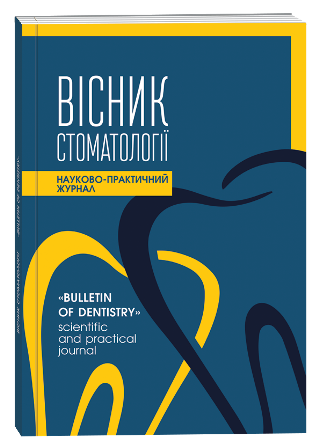FEATURES OF THE STRUCTURE OF THE DENTAL ARCHES IN CHILDREN WITH A DISTAL RATIO OF THE FIRST PERMANENT MOLARS
DOI:
https://doi.org/10.35220/2078-8916-2025-55-1.16Keywords:
distal occlusion, dental arches, apical base, mesial drift, childrenAbstract
A distal relationship of the first permanent molars in children is a common malocclusion that produces space deficiency, occlusal disturbances and compromised smile aesthetics. Detailed knowledge of arch morphology under these circumstances is essential for early diagnosis and appropriate orthodontic planning. Purpose of the study was to evaluate the morphological features of dental arches in children with a distal relationship of the first permanent molars. Research methods. Eighty-ninepatients aged 8–16 years were examined; 52 underwentan in-depth assessment of study casts and were allocated to three etiological subgroups. Linear and angular parameters were measured on plaster models (Gerlach,Schmuth methods); statistics were performed in Microsoft Excel 2016 using Student’s t-test (p < 0,01). Scientific novelty. All subgroups showed shortening and/orconstriction of the maxillary arch. Classic distal occlusionrevealed constriction in the premolar (1,30 ± 0,62 mm) and molar (1,77 ± 0,92 mm) regions. When early lossof deciduous teeth caused mesial migration, the greatestreductions in arch length (7,86 ± 1,09 mm) and apical base (4,94 ± 0,54 mm) were recorded. Size discrepancybetween deciduous and permanent crowns produced severe space shortage, molar rotation and buccal eruptionof canines (molar constriction – 6,34 ± 1,02 mm).Conclusions. A distal relationship of the first permanentmolars is accompanied by a characteristic cluster ofarch alterations – constriction, shortening and rotationof posterior teeth, whose severity depends on etiology.Recognising these patterns is crucial for shortening treatment time and preventing complications.
References
De Lira Ade L., Prado S., Araújo M.T., Sant’Anna E.F., Ruellas A.C. Distal movement of upper permanent molars using midpalatal mini-implant. Dental Press J Orthod. 2013 Mar 15. Vol. 18. № 2. P. 18.e1–5. doi: 10.1590/s2176-94512013000200006.
Gianelly A.A. Distal movement of the maxillary molars. Am J Orthod Dentofacial Orthop. 1998 Jul. Vol. 114. № 1. P. 66–72. doi: 10.1016/s0889-5406(98)70240-9.
Alshammari A., Almotairy N., Kumar A., Grigoriadis A. Effect of malocclusion on jaw motor function and chewing in children : a systematic review. Clin Oral Investig. 2022 Mar. Vol. 26. № 3. P. 2335–351. doi: 10.1007/s00784-021-04356-y.
De Ridder L., Aleksieva A., Willems G., Declerck D., Cadenas de Llano-Pérula M. Prevalence of Orthodontic Malocclusions in Healthy Children and Adolescents: A Systematic Review. Int J Environ Res Public Health. 2022 Jun 17. Vol. 19. № 12. P. 7446. doi: 10.3390/ijerph19127446.
Londono J., Ghasemi S., Moghaddasi N., Baninajarian H., Fahimipour A., Hashemi S., Fathi A., Dashti M. Prevalence of malocclusion in Turkish children and adolescents : A systematic review and meta-analysis. Clin Exp Dent Res. 2023 Aug. Vol. 9. № 4. P. 689–700. doi: 10.1002/cre2.771.
Caruso S., Nota A., Ehsani S., Maddalone E., Ojima K., Tecco S. Impact of molar teeth distalization with clear aligners on occlusal vertical dimension: a retrospective study. BMC Oral Health. 2019 Aug 13. Vol. 19. № 1. P. 182. doi: 10.1186/s12903-019-0880-8.
Köle H. Surgical operations on the alveolar ridge to correct occlusal abnormalities. Oral Surg Oral Med Oral Pathol. 1959 May. Vol. 12. № 5. P. 515–29 concl. doi: 10.1016/0030-4220(59)90153-7.
Рогач І.М., Керецман А.О., Сіткар А.Д. Правильно вибраний метод статистичного аналізу – шлях до якісної інтерпретації даних медичних досліджень. Науковий вісник Ужгородського університету. 2017. Вип. 2. С. 124–28.









